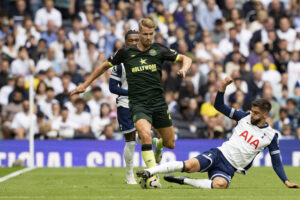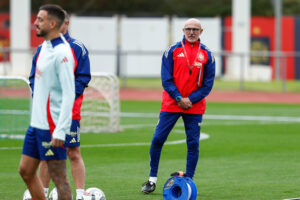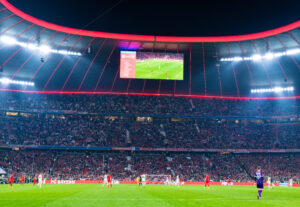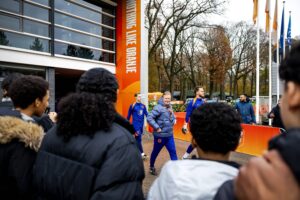Welcome to Last Word on Football’s ‘Returning Players’ series. In this edition, we take a look at Ian Rush. Rush played for Liverpool from 1980 to 1987 and 1988 to 1996, spending one season in Italy in between his stints.
Returning Players – Ian Rush
First Spell at Liverpool
Ian Rush grew up as an Everton fan but in April of 1980, he went across Stanley Park and signed for Merseyside rivals Liverpool aged 18. Manchester City were also interested in signing the young striker, but it was Liverpool who got their man. A legend was about to be born as he left Chester City for a career in the big time.
The fee paid for Rush was £300,000 and in May 1980, he made his international debut for Wales. He wouldn’t make his debut for Liverpool until December 13, 1980, after remaining with Chester City until the end of the 1979/80 season due to his signing just missing the transfer deadline. His debut was against Ipswich Town and he wore the number seven shirt, usually worn by Kenny Daglish, but the Scot was injured.
Rush’s first goal for Liverpool came in a European tie against Oulun Palloseura when he scored in a 7-0 win after coming on as a second-half substitute.
Rush then scored his first two league goals for the club when he netted a brace against Leeds United in a 3-0 win at Anfield. It was followed by a goal in the Merseyside Derby, which did nothing to harm his place in the Anfield fans’ hearts.
Rush ended the season as a league title winner, scoring 17 league goals and 30 goals in 49 appearances in all competitions. The £300,000 paid to Chester City was proving to be a bargain.
1983 saw Rush help Liverpool to a second successive league and League Cup double and his efforts saw him awarded the PFA Young Player of the Year. Another Merseyside Derby in November 1982 had also seen Rush destroy Everton, grabbing four goals in a 5-0 demolition of his boyhood club.
1984 would prove to be an incredible season for both Rush and Liverpool as they won the league, League Cup and European Cup when Liverpool beat AS Roma in one of footballs’ most famous penalty shoot-outs. Rush scored his penalty to put Liverpool 3-2 ahead in the shootout before the antics and wobbly legs of goalkeeper Bruce Grobbelaar led to Reds the victory. Rush managed 47 goals in 65 games in all competitions and his strike partnership with Dalglish was striking fear into every defence in world football.
Juventus would become a club of some significance for Ian Rush, starting with the ill-fated 1985 European Cup final, in which Liverpool lost 1-0 to the Italian giants. But, it was events off the field that grabbed the headlines. A retaining wall came down as Liverpool supporters charged towards opposing fans, leading to the tragic deaths of 39 Juventus supporters. The incident led to an indefinite ban for all English clubs from European competition.
Liverpool then lost the title race to rivals Everton and Rush and the Reds ended the season without a trophy. Normal service was resumed in the 1985/96 campaign as the club won their first and only league and FA Cup final double success. The FA Cup final was a Merseyside Derby and it was Rush who scored Liverpool’s third goal to see them emerge 3-1 victors.
In 1986, Rush would be linked with a move away from Liverpool and Juventus would once more be part of his life.
Teams That Rush Played for in Between
Despite Rush signing for Juventus in 1986, he remained a Liverpool player, continuing to score goals while on a season-long loan. He managed 30 goals but ended without any winners medals as Everton were again crowned league champions.
Juventus was seen as a huge challenge for Rush but his time there was far less successful than his time with Liverpool. He struggled to settle into life abroad and found the physical and defensive nature of Italian football hard to adapt to.
Just seven goals in 29 Serie A games was a far cry from his goalscoring exploits in England and he managed just one season before he became one of footballs’ returning players.
Return to Liverpool
August 18, 1988, saw Rush move back to Liverpool, joining for a fee of £2.7 million. The Liverpool team he had left behind had somewhat changed with Kenny Dalglish as player-manager rarely playing, and Peter Beardsley and John Aldridge being the main strike force. Aldridge was similar in appearance to Rush; slight and moustached with a knack of being in the right place at the right time to score goals for fun, just as Rush had done in his first stint with the club.
The similarities in appearance between Aldridge and Rush were one thing but Dalglish felt the pair were also too similar in playing style, and Aldridge was the man who started the majority of games with Rush having to settle for a place on the bench.
Rush still had the goalscoring knack though and in the 1989 FA Cup final, once more against Everton, he came from the bench to score twice and give Liverpool the win after extra time. The final itself was played against a backdrop of tragedy as 96 Liverpool fans lost their lives during the horrific scenes at Hillsborough in the semi-final against Nottingham Forest. Rush went to many of the funerals along with his teammates.
Rush won his final league winners medal in the 1989/90 season as he helped Liverpool finish above Aston Villa. Despite playing a further six seasons at Anfield, Rush would only win one more FA Cup and one more League Cup as Liverpool’s domestic dominance was coming to an end.
Returning Players – Ian Rush’s Impact on His Return to Merseyside
Ian Rush will forever be a Liverpool legend. Even in his later career at the club, he was still able to contribute goals and, despite being a substitute for most of the 1992/93 season, he still managed to grab 11 goals in just two months, and was the club’s top scorer with 14 goals. He was the top scorer again the following season as he enjoyed a partnership with Nigel Clough before being replaced for many games by a young striker called Robbie Fowler.
Rush was a clever player. His movements in the box were so subtle that defenders struggled to track him and his goals were vital in the successes that Liverpool achieved, particularly in the 1980s. His impact is still felt today and he is one of those returning players that was always best when he was truly ‘at home’. He remains the club’s top scorer with 346 goals.
Main Photo






